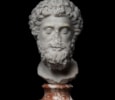Bust of Marcus Aurelius
Bust of Marcus Aurelius
Circa 170-180 A.D., Antonine Period,
Roman
Marble
H: 45 cm
Sold
A marble portrait head of the Roman emperor Marcus Aurelius (r. 161-180 A.D.), in his fourth and final portrait type. Known as the Capitoline Imperatori 38 type, after the most famous example, these portraits were created towards the end of his reign, between 170 and 180 A.D. The emperor is depicted with a long beard, falling in waves and coils around his chin. His hair is full and curled high over the face, and falls in orderly rows on the reverse. His facial features are stern, without appearing harsh, with firmly set eyebrows slightly drawn together above sharp almond-shaped eyes. Strong cheekbones and a pensively downturned mouth complete the image of the emperor as ruler and philosopher.
The later portraits of Marcus Aurelius embody his status as emperor and one of the great Stoic philosophers. He was trained in philosophy and governance from a young age. Despite the economic and military pressures affecting his reign, he endeavoured to write a philosophical treatise in Greek. His Meditations are a series of metaphysical reflections on duty, virtue, justice, and the subordination of the individual to the tasks facing the wider community, which still hold value today: ‘People exist for the sake of one another; teach them, then, or bear with them’. Historians Cassius Dio (c. 155-235 A.D.) and the author of the fourth century Historia Augusta, refer to Marcus Aurelius as ‘the philosopher’. He was introduced to philosophy in his early teens, around 132 A.D., by a teacher named Diognetus. He was probably introduced to the Cynic Philosophers, who sought to live a simple life and disregard all social conventions as artifice, which Aurelius followed – opting to dress in a rough woollen cloak, and sleeping on the ground rather than a bed. He was also tutored in oratory and rhetoric by the highly respected Herodes Atticus and Marcus Cornelius Fronto, who advised him throughout his life. The fuller beard of his later portraits symbolises wisdom and philosophical depth, and his features hold an introspective seriousness. As with Hadrian and Antoninus Pius before him, Marcus Aurelius’s portraits recall those of Greek philosophers from five hundred years previous, with broad faces, thick beards and curled hair.
Marcus Aurelius was betrothed to Ceionia Fabia, daughter of respected politician Lucius Ceionius Commodus, and sister of his future co-emperor, Lucius Verus (r. 161-169 A.D.). In 136 A.D., Hadrian selected Lucius Ceionius Commodus as his successor, possibly in order to secure the succession of the then teenage Aurelius. After Commodus died in 138 A.D., Hadrian then selected Aurelius Antoninius as his successor, on the stipulation that he adopted Aurelius and Lucius Verus as his sons and successors. Aurelius’s earlier betrothal was annulled and he was married to Antoninus’ daughter Anna Galeria Faustina (known as Faustina the Younger) in 145 A.D.. Antoninus coached Aurelius on how to become an efficient ruler, and brought Apollonius of Chalcedon and the Stoic Quintus Junius Rusticus to court to tutor him in philosophy.
When Antoninus Pius died in 161 A.D., Aurelius refused to accept the role of emperor unless Lucius Verus was elevated alongside him. The pair began their reign by instituting programs to help the poor and reward the military with greater pay and honour. They encouraged free speech, the arts, education, and boosted the economy by debasing the currency; making the two emperors highly popular with the people. While Verus was fighting the Parthian Wars (161-166 A.D.), Aurelius remained and Rome and managed internal affairs, until 167, when he joined the campaign against the Marcomanni tribe of Germania and the Persia Sarmatians. Verus died in 169 A.D., and Aurelius continued to rule alone, and spent much of the remainder of his reign in the field against the Germanic tribes. Aurelius led Rome to victory in 178 A.D., and retired to winter quarters at Vindobona, where he died in 180 A.D.. His Meditations were copied and preserved, with the first printed edition published in 1559.
Musée d’Art Classique de Mougins, Mougins, France, 2011-2023, inv. no. MMoCA364.
Christopher Gibbs, ‘Acquired Tastes’, The World of Interiors (May 1991).
Lisa Lovatt-Smith, London Living (London and New York, 1997), p. 103.
Antiquities, Christie’s, London, 7 November 2001, Lot 328.
Mark Merrony (ed.), Mougins Museum of Classical Art (Mougins, 2011), pp. 11, 99, fig. 50.
Mark Merrony, Musée d’Art Classique de Mougins: La collection famille Levett (Mougins, 2012), pp. 10, 59.
N. Nussbaum, ‘Un Ken d'Or pour le Musée d'Art Classique’, Nice- Matin, 5 January 2013, p. 12.
‘C'est quoi cette oeuvre?’, Mougins Infos, February 2013.
‘L'or pour le Musee d'art Classique de Mougins’, Les étoiles de Mougins, January-March 2013, p. 8.
‘Les autres salles’, Egypte Ancienne, 8 (May-July 2013), p. 69.
France Today, June-July 2014, p. 63.
S. Davis, ‘Museum Watch: Mougins Classical Art Museum’, France Today, December/January 2013-2014, p. 15.
N. Nussbaum, ‘L'art se met au vert avec Covoiture-Art’, Nice-Matin, 14 June 2016, p. 9.
‘Museums and More in the Alpes-Maritimes’, France Today, 34:3 (April-May 2019), p. 44.
Ricko Leung, ‘From 4th-Century Greek Vases to Female Abstract Expressionism’, Larry’s List https://www.larryslist.com/artmarket/the-talks/from-4th-century-greek-vases-to-female-abstract-expressionism/ (2022).
Most likely previously in an Eighteenth/Nineteenth-Century Private Collection, based on the old collection base.
Private Collection of Piers von Westenholz (b. 1943), Much Hadham, East Hertfordshire, U.K., 1970s.
With Peter Hinwood (b. 1946), London, acquired from the above, 1984.
Sold at: Antiquities, Christie’s, London, 7 November 2001, Lot 328.
Private Collection, U.K., London, acquired from the above sale.
Musée d’Art Classique de Mougins, Mougins, France, acquired from the above, 2009 (accompanied by French cultural passport 24332).
ALR: S00256674, with IADAA Certificate, this item has been checked against the Interpol database.










 Enquire
Enquire




